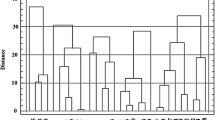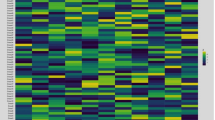Abstract
Six okra [Abelmoschus esculentus (L.) Moench.] varieties were studied for the growth and yield at two different planting dates in 2016 and 2017 in the Research Farm of Department of vegetable crops, Faculty of Agriculture, Assiut University, Egypt. The experiments were carried out in a split-plot design. The results revealed that the measured growth, yield attributes and yield parameters (days to flowering, plant height, no. of branches/plant, no. of fresh pods/plant, weight of fresh pods/plant, length of fresh pods and total yield of fresh pods) of the studied varieties were significantly affected by planting dates. The early planting date ‘15th of March’ enhanced growth and yield parameters of the okra variety ‘Pusa Sawani’. The varieties ‘Iraqi’ and ‘Hala’ were less adapted to Upper Egypt weather. The okra variety ‘Pusa Sawani’ showed the highest performance under Assiut weather and was suggested to cultivate at summer season in Upper Egypt. The six okra varieties were grouped into four clusters based on agro-morphological traits. Among these varieties, ‘Pusa Sawani’ variety was separated only in a cluster which had the highest mean values for most of agro-morphological traits. The six varieties were screened for drought, salinity and heat stress at early growth seedling. Significant variation was observed among the varieties. These varieties were grouped into two main clusters based on tolerance indices. Three molecular marker techniques, ISSR, SRAP and SSR were used to study the genetic diversity among the six varieties and to detect markers related to agro-morphological traits and drought, salinity and heat stress tolerance. These results revealed at least one marker related to agro-morphological traits and/or drought, salinity and heat tolerance.







Similar content being viewed by others
References
Abbas T, Pervez MA, Ayyub CM, Shaheen MR, Tahseen S, Shahid MA, Bilal RM, Manan A (2014) Evaluation of different okra genotypes for salt tolerance. Int J Plant Anim Environ Sci 4(3):23–30
Adiroubane D, Letachoumanane S (1992) Growth and yield performance of okra (Abelmoschus esculentus L.) cultivars. Indian J Agric Sci 68:168–170
Akinyele BO, Osekita OS (2006) Correlation and path coefficient analyses of seed yield attributes in okra (Abelmoschus esculentus L. Moench). Afr J Biotechnol 5:13330–13336
Amoatey HM, Klu GYP, Quartey EK, Doku HA, Sossah FL, Segbefia MM, Ahiakpa JK (2015) Genetic diversity studies in 29 accessions of okra (Abelmoschus spp (L.) using 13 quantitative traits. Am J Exp Agric 5(3):217–225
Asghar S (2016) Screening of different okra genotypes against heat stress okra to heat stress. Int J Biomed Sci Bioinform 3(2):29–32
Baghizadeh A, Hajmohammadrezaei M (2011) Effect of drought stress and its interaction with ascorbate and salicylic acid on okra (Hibiscus esculents L.) germination and seedling growth. J Stress Physiol Biochem 7(1):55–65
Bello BO, Aminu D (2017) Genetic relationships among okra (Abelmoschus esculentus (L.) Moench) cultivars in Nigeria. Acta Agric Slov 109(2):251–260
Chattopadhyay A, Dutta S, Chatterjee S (2011) Seed yield and quality of Okra as influenced by sowing dates. Afr J Biotechnol 10(28):5461–5467. https://doi.org/10.5897/ajb10.979
Cong-Ying Y, Zhang C, Wang P, Hu S, Chang HP, Xiao WJ, Lu XT, Jiang SB, Ye JZ, Guo XH (2014) Genetic diversity analysis of okra (Abelmoschus esculentus L.) by inter-simple sequence repeat (ISSR) markers. Genet Mol Res 13(2):3165–3175
Cong-Ying Y, Wang P, Chen P, Xiao W, Zhang C, Hu S, Zhou P, Chang H, He Z, Hu R, Lu X, Ye J, Guo X (2015) Genetic diversity revealed by morphological traits and ISSR markers in 48 Okras (Abelmoschus esculentus L.). Physiol Mol Biol Plants 21(3):359–364
Dasgan HY, Aktas H, Abak K, Cakmar I (2002) Determination of screening techniques to salinity tolerance in tomatoes and investigation of genotypes response. Plant Sci 163(4):695–703. https://doi.org/10.1016/S0168-9452(02)00091-2
Dash PK, Rabbani G, Mondal F (2013) Effect of variety and planting date on the growth and yield of Okra. Int J Biosci 3(9):123–131
Dice LR (1945) Measures of the amount of ecologic association between species. Ecology 26:297–302. https://doi.org/10.2307/1932409
Doyle JF, Doyle JL (1990) A rapid DNA isolation procedure for small quantities of fresh leaf tissue. Focus 12(1):13–15
El-hag AZ, Ahmed AA (2014) Effect of cultivar and sowing date on okra (Abelmoschus esculentus L. Moench) seed yield. Univers J Appl Sci 2(3):64–67
El-Sherbeny GAR, Khaled AGA, Obiadalla-Ali HA, Ahmed AYM (2018) ISSR markers linked to agronomic traits in okra. Int J Mod Agric 7(1):9–12
F.A.O. (2014). http://faostat.fao.org
Fufa H, Baenziger PS, Beecher BS, Dweikat I, Graybosch RA, Eskridge KM (2005) Comparison of phenotypic and molecular marker-based classifications of hard red winter wheat cultivars. Euphytica 145:133–146
Ghislain MD, Fazardo ZD, Huaman Z, Hismans RH (1999) Marker assisted ampling of the cultivated Andean Potato (Solanum fureja) collection using RAPD markers. Genet Resour Crop Evol 46:547–555
Gomez KA, Gomez AA (1984) Statistical procedures for agricultural research, 2nd edn. Wiley, New York
Greenway H, Munns R (1980) Mechanisms of salt tolerance in nonhalophytes. Annu Rev Plant Phy 31:149–190
Gulsen O, Karagul S, Abak K (2007) Diversity and relationships among Turkish okra germplasm by SRAP and phenotypic marker polymorphism. Biologia Bratislava 62(1):41–45
Howarth CJ (2005) Genetic improvements of tolerance to high temperature. In: Ashraf M, Harris PJC (eds) Abiotic stresses: plant resistance trough breeding and molecular approaches. Howarth Press Inc., New York
Kaur K, Pathak M, Kaur S, Pathak D, Chawla N (2013) Assessment of morphological and molecular diversity among okra [Abelmoschus esculentus (L.) Moench.] germplasm. Afr J Biotechnol 12(21):3160–3170
Kumar S, Parekh MJ, Fougat RS, Patel SK, Patel CB, Kumar M, Patel BR (2017) Assessment of genetic diversity among okra genotypes using SSR markers. J Plant Biochem Biotechnol 26(2):172–178
Kyriakopoulou OG, Paul A, Koen TBP, Ioannis K, Penelope B, Harold CP (2014) Genetic and morphological diversity of okra (Abelmoschus esculentus [L.] Moench.) genotypes and their possible relationships, with particular reference to Greek landraces. Sci Hortic 171:58–70
Li G, Quiros CF (2001) Sequence-related amplified polymorphism (SRAP), a new marker system based on a sample PCR reaction: its application to mapping and gene tagging in Brassica. Theor Appl Genet 103:455–461
Macar KT (2009) Effects of water deficit induced by PEG and NaCl on chickpea (Cicer arietinum L) cultivars and lines at early seedling stages. Gazi Univ J Sci 22(1):5–14
Mantel N (1967) The detection of disease clustering and a generalized regression approach. Cancer Res 27(2):209–220
Michael BE, Kaufman MR (1973) The osmotic potential of polyethylene glycol-6000. Plant Physiol 51:914–916
Mousa MAA, Hassan SA, Ashraf GH (2012) Row configuration yield and economics of Okra intercropped with Eggplant. Int J Veg Sci 18(4):358–369
Murillo-Amador B, Lopez-Aguilar R, Kaya C, Mayoral JL, Flores HA (2002) Comparative effect of NaCl and PEG on germination emergence and seedling growth of cowpea. J Agron Crop Sci 188:235–247
Naser MS (2014) Genetic Diversity of okra [Abelmoschus esculentus (L.) Moench] landraces from different agro-ecological regions revealed by AFLP analysis. Am-Eurasian J Agric Environ Sci 14(2):155–160
Ouedraogo MH, Dogo NS, Batieno T, Wend-Pagnangdé MSFZ, Ali LB, Antoine B, Zakaria K, Mahamadou S (2018) Evaluation of genetic diversity of okra accessions [Abelmoschus esculentus (L. Moench)] cultivated in Burkina Faso using microsatellite markers. Afr J Biotechnol 17(5):126–132
Patade VY, Maya K, Zakwan A (2011) Seed priming mediated germination improvement and tolerance to subsequent exposure to cold and salt stress in capsicum. Res J Seed Sci 4(3):125–136
Patel JS, Japda AR, Dhruve JJ (2018) Assessment of genetic diversity of okra (Abelmoschus esculentus L.) for YVMV using RAPD and SSR markers. IJABR 8(2):217–223
Powell W, Machray GC, Provan J (1996) Polymorphism revealed by simple sequence repeats. Trends Plant Sci 1:215–222
Prevost A, Wilkinson MJ (1999) A new system for comparing PCR primers applied to ISSR fingerprinting of potato cultivars. Theor Appl Genet 98:107–112
Provan J, Thomas WTB, Forster BP, Powell W (1999) Copia-SSR: a simple marker technique which can be used on total genomic DNA. Genome 42:363–366
Ravishankar KV, Muthaiah G, Mottaiyan P, Gundale SK (2018) Identification of novel microsatellite markers in okra (Abelmoschus esculentus (L.) Moench) through next-generation sequencing and their utilization in analysis of genetic relatedness studies and cross-species transferability. J Genet 97:39–47
Rholf F (2002) NTSYS-pc: numerical taxonomy and multivariate analysis system version 2.2. Department of Ecology and Evolution, State University of New York, New York
Singh N, Azharudheen M, Yadava DK, Vasudev S, Naresh S, Singh R, Prabhu KV (2012) A reliable protocol for high temperature screening at early seedling stage in Brassica juncea. In: International conference on sustainable agriculture for food and livelihood security, Punjab, India, pp 27–29
Singh D, Dudi BS, Dhankhar SK, Kumar R (2018) Genetic diversity analysis of okra genotypes using morphological markers. Int J Curr Microbiol Appl Sci 7(1):1667–1675
Soltani A, Gholipoor M, Zeinali E (2006) Seed reserve utilization and seedling growth of wheat as affected by drought and salinity. Environ Exp Bot 55:195–200
Taherkhani T, Rahmani N, Pazoki A (2013) The effect of hydro-priming on germination of mustard seeds under drought stress conditions. Life Sci J 10:392–395
Terzopoulos PJ, Bebeli PJ (2008) Genetic diversity analysis of Mediterranean faba bean (Vicia faba L.) with ISSR markers. Field Crops Res 108(1):39–44. https://doi.org/10.1016/j.fcr.2007.08.006
Umrao V, Sharma SK, Kumar R, Kumar V, Sharma A (2014) Genetic variability and divergence analysis in okra [Abelmoschus esculentus (L.) Moench]. Hort Flora Res Spectr 3(2):127–132
Vogel J, Rafalski M, Powell A, Morgante W, Andre M, Hanafey C, Tingey SV (1996) Application of genetic diagnostics to plant genome analysis and plant breeding. Hortic Sci 31:165–167
Zietkiewicz E, Rafalski A, Labuda D (1994) Genome fingerprinting by simple sequence repeat (SSR)-anchored polymerase chain reaction amplification. Genomics 20:176–183
Acknowledgements
The authors would like to deeply appreciate the support provided by the Faculty of Agriculture, Assiut University, Egypt.
Author information
Authors and Affiliations
Corresponding author
Ethics declarations
Conflict of interest
The author declares no conflict of interest.
Research involving human participants and/or animals
This article does not contain any studies with human or animal subjects.
Additional information
Publisher's Note
Springer Nature remains neutral with regard to jurisdictional claims in published maps and institutional affiliations.
Electronic supplementary material
Below is the link to the electronic supplementary material.
Rights and permissions
About this article
Cite this article
Abd El-Fattah, B.E.S., Haridy, A.G. & Abbas, H.S. Response to planting date, stress tolerance and genetic diversity analysis among okra (Abelmoschus esculentus (L.) Moench.) varieties. Genet Resour Crop Evol 67, 831–851 (2020). https://doi.org/10.1007/s10722-019-00821-6
Received:
Accepted:
Published:
Issue Date:
DOI: https://doi.org/10.1007/s10722-019-00821-6




